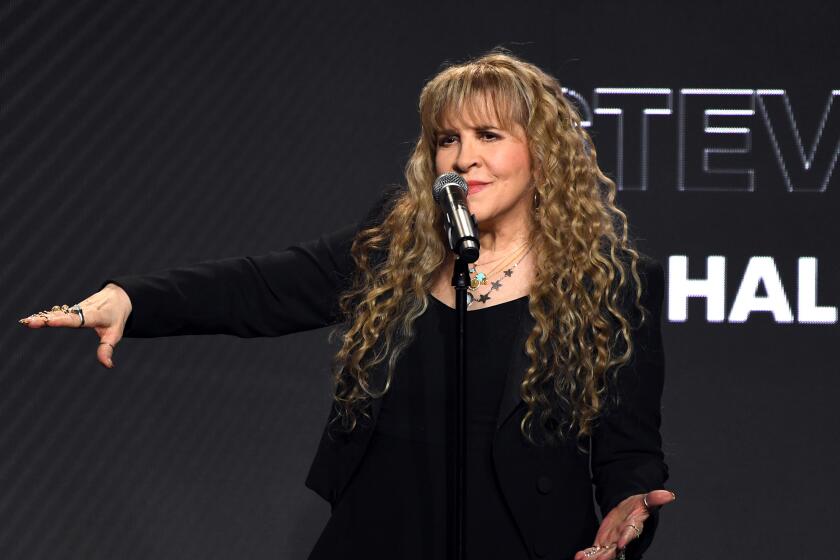Women Make Inroads in Non-Western Pop
- Share via
J ames Brown once sang “It’s a man’s world,” and that’s largely been the case in pop music. The situation is no different in the non-Western pop world, where the impetus for new styles has come from male artists.
But more women artists are getting recorded, and some have even gained exposure in the Western pop world. Probably the most famous is Israeli pop singer Ofra Haza, even if her recent Sire album “Shaday” did submerge the most distinctive elements of her music in favor of a dance-rock diva stance.
Fans enraptured by the Haza whose vocals were so eye-opening on Eric B. & Rakim’s “Paid in Full” rap should be equally entranced by the singing of the Anglo-Indian vocalist Najma. Her album “Qareeb” is one of six by female artists considered in this edition of On the Off Beat, a periodic review of roots, ethnic and non-mainstream pop recordings from around the world.
NAJMA
“Qareeb.” Shanachie.
Ghazals are poems, almost always about the sorrows of unrequited love, that have constituted a standard body of material for Indian singers for centuries. Najma’s take on the venerable tradition involves a small group featuring both classic Indian instruments and saxophone, bass and keyboards. The cross-cultural blend is stunning on “Qareeb.”
Why? Maybe it’s because Naushad Sheikh’s tablas set up such an irresistibly sprightly pulse on “Neend Koyi” and “Zikar Hai Apna Mehfil Mehfil,” or because the intertwined soprano sax and violin on portions of “Karoon Na Yad Magar” recall early Roxy Music, or because Najma’s double-tracked harmony vocals on “Dil Laga Ya Tha” sound like the Everly Sisters. “Qareeb” is utterly beguiling--precisely the kind of blend of traditional and modern sensibilities that make international pop so fascinating.
AMINA CLAUDINE MYERS
“Salutes Bessie Smith.” Leo (English import).
Bessie Smith has been frequently saluted, but never so effectively as on this album by pianist/vocalist Myers. Myers has strong jazz roots but her musical base--from this CD release of a 1981 album through her current LP on RCA/Novus--is bedrock gospel and blues. That makes her a perfect interpreter of Smith.
Myers doesn’t try to out-belt Smith on the one side of the latter’s material here, but her version of “Worried Life Blues” is transcendent. The two Myers originals on the second side are more expansively in the jazz vein--maybe too much so for pop-bred ears. But the Smith tunes alone make this album memorable, and “Worried Life Blues,” well, that’s just a hall-of-fame performance.
OUARDIA
“Assirem.” GlobeStyle (English import).
The Algerian sings modern kabyle music, a style rooted in the Berber tradition of North Africa. Over a rhythmic base of loping percussion, guitars, banjos, flutes and fiddles weave lengthy melodies around warbled vocals that, surprisingly, often resemble a less polished version of Najma’s. The buoyant “Ouine Hemlegh and “Yir Thayri” are the standout tracks on an album that wins most of its points for its rough, understated charm.
CHABA FADELA.
“You Are Mine.” Mango.
A rai record, featuring the Algerian pop style that began about 10 years ago when artists blended traditional Bedouin chants with the studio technology of synthesizers and drum machines. Fadela was the first prominent female artist in rai , and now she’s the first individual rai artist to have an album released in America.
Fadela isn’t the only creative force here--producer Rachid Baba Ahmed contributed the bulk of the instrumental tracks, and Fadela’s husband Cheb Sahraoui chipped in on the title duet. The rough synthesizer harmonies on “Nebki Ouahdi” and the call-and-response interplay on “Ha-Liya-Ouana Alach,” where a straight Western pop organ-guitar hook is immediately answered by a distinctly Arabic synthesizer line, are the most striking examples of Ahmed’s techniques for surrounding Fadela’s voice with swirling melodic eddies.
“You Are Mine” is a fine album, but it raises questions about the style’s long-range potential here. Rai falls into a strange netherworld--it’s pulsating trance music that doesn’t sound pushy enough for the hard-core dance crowd, but is too moody and mysterious for the music-to-meditate-by set. The first new-age/dance-music crossover?
STELLA CHIWESHE
“Ambuya?” GlobeStyle (English import).
Chiweshe was the first woman to be accepted playing mbira music, the traditional Zimbabwean style from which the pop sounds of Thomas Mapfumo (and, through him, the Bhundu Boys) were adapted. On “Ambuya?,” mbira (thumb piano), hosho (maracas) and marimbas adroitly create webs of interlocking melodies and rhythms similar to those found in Zimbabwean pop. It’s very light and lilting music, but the strategic, largely unobtrusive injection of the 3 Mustaphas 3 rhythm section on some tracks provides variety and a frame of reference for Western fans.
MEMPHIS MINNIE
“I Ain’t No Bad Gal.” Portrait Masters.
Women were originally the big record-sellers in the blues field--among them Memphis Minnie, who was hugely popular in the ‘30s and ‘40s before Chicago blues took an amplified turn. This reissue of two 1941 sessions isn’t country blues in the bottleneck guitar style of a Robert Johnson. Minnie’s steely yet soulful singing and accomplished guitar strumming are abetted by her regular partner, guitarist/songwriter Ernest (Little Son Joe) Lawler, on the dozen tracks here. The tempos and melodies aren’t varied enough, but the celebrated “Me and My Chauffeur Blues” and “Can’t Afford to Lose my Man” highlight a strong introduction to an often overlooked artist and era.
More to Read
The biggest entertainment stories
Get our big stories about Hollywood, film, television, music, arts, culture and more right in your inbox as soon as they publish.
You may occasionally receive promotional content from the Los Angeles Times.










